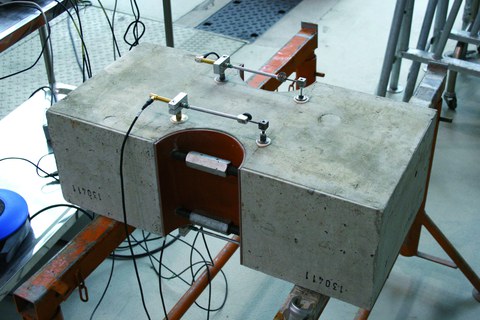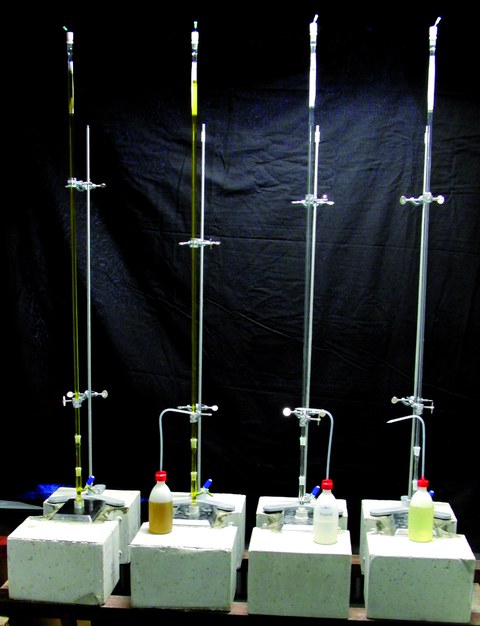Evaluation the reliability level of components with small separating cracks
Table of contents
Project data
| Titel | Title Beurteilung des Zuverlässigkeitsniveaus von Bauteilen mit kleinen Trennrissen | Evaluation the Reliability Level of Components with Small Separating Cracks Förderer | Funding Ministerium für Landwirtschaft, Umwelt und Verbraucherschutz Mecklenburg-Vorpommern, Länderfinanzierungsprogramm „Wasser, Boden und Abfall“ Zeitraum | Period 03.2011 – 02.2012 Leiter | Project Manager Prof. Dr.-Ing. Dr.-Ing. E.h. Manfred Curbach Bearbeiter | Contributor Martin Just M.Sc. |
Report in the yearbook 2012
Can Cracked Concrete be Leak-Proof?

Versuchsstand während der Beaufschlagung mit verschiedenen wassergefährdenden Stoffen
For facilities that are used for storage, filling and transfer of water polluting substances (in short: SFH facilities), it is very important that these substances are not released into the environment. Ensuring the permanent leak-tightness of such facilities is therefore very significant. In addition to the primary sealing constructions of steel, reinforced concrete is often used as a secondary sealing barrier.
Building reinforced concrete free of cracks is complex and expensive, so in the planning it would be helpful from an economic perspective, if small cracks could be acceptable. But can a cracked reinforced concrete part still be really leak-proof?
To verify this, experiments were performed in which specimens, which had a very small separation crack (crack width of 0.05 mm) were subjected to substances hazardous to water. It was observed whether within a period of 72 h the liquid passes through the specimen and if so at what time. If the specimen was not penetrated within the 72 hours, the depth of penetration was determined by separating the specimen in the crack and photographing the level of penetration at the crack surface.
The investigated liquids, with the exception of water, biodiesel and quinolone, leaked well ahead of the required duration of 72 h through the 20 cm thick specimen. For the other three liquids the required duration has just been achieved.
In addition, studies were conducted on the accuracy of the prediction of crack widths. Particularly small cracks cannot be accurately predicted. Therefore, the discrepancies between predicted and actual measured (on real specimens) crack widths were examined for different crack width models using a database.
In combination of the two studies, the reliability of sealing reinforced concrete structures in the presence of separation cracks can be determined. Based on the experimental results this evaluation was possible only for biodiesel and led to the conclusion, that elements in LAU facilities made of reinforced concrete have to be designed crack free, when dealing with substances with low viscosity. This is passed as a recommendation to the appropriate committee of experts at the DIBt and is used in the directive „concrete construction when dealing with substances hazardous to water“ and the Technical Rules for Substances hazardous to Water (TRwSn) which are made by the DIBt.
Report in the yearbook 2011
Leak Proof Elements Made of Reinforced Concrete with Small Separation Cracks

Test set up during impingement with different fluids hazardous to water
In the design of facilities which are used for storage, filling and handling of chemical substances (substances hazardes to water – in short: SFH facilities) it is of utmost priority to ensure that leakage of such substances in the environment and thus in water is avoided under all circumstances. Therefore, it has to be ensured, that a critical depth of penetration is not reached due exposure time, even when separation cracks occur.
It is necessary to determine whether a defined reliability and safety can be ensured when designing such facilities with the given approaches. Doubts arise primarily from the accuracy of the prediction of the crack widths. For SFH facilities, only very small crack widths w ≤ 0.1 mm are maximum permissible. But using current crack width models, especially in this range of fine cracks, the achievable accuracy is too low and therefore insufficient.
To determine the actual reliability level of such facilities or elements, the variances of both, the crack widths actually occurring and also the penetration depths, have to be known. A large amount of data is available to generate the dependence between the calculated crack widths and the actually occurring ones. On the side for the penetration depth data for a statistical analysis are not available. Therefore own experiments are performed for ten liquids, in which over a fixed period of time each liquid has to be tested on a concrete specimen with predefined crack width.
The data obtained in the experiments are used for making a statistically robust verification of the model for the design of elements with small separating cracks in SFH facilities regarding to its reliability.
